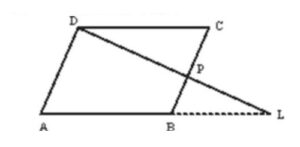Q) ABCD is a parallelogram. P is a point on side BC and DP when produced meets AB produced at L. Prove that:

(i) ![]()
(ii) ![]()
(iii) If LP : PD = 2 : 3, then find BP : BC
Ans: (i) Solution for ![]() :
:
Step 1: Since DC ǁ AB (and hence AL)
and Line CB cuts these parallel lines,
Therefore, ∠ DCB = ∠ CBL
∴ ∠ DCP = ∠ PBL ……… (i)
Step 2: Similarly, Line DL cuts the parallel lines CD and AL,
Therefore, ∠ CDL = ∠ ALD
∴ ∠ CDP = ∠ BLP …. (ii)
Step 3: Let’s compare Δ DCP with Δ PBL
We have ∠ DCP = ∠ PBL [from equation (i) ]
and ∠ CDP = ∠ BLP . [from equation (ii) ]
Therefore, by AA similarity rule, 
∴ Δ DCP ~ Δ PBL
∴ ![]()
(ii) Solution for ![]()
Step 1: Line DL cuts the parallel lines CD and AL,
Therefore, ∠ CDL = ∠ ALD
∴ ∠ CDP = ∠ ALD (interior angles) ….. (i)
Step 2: Since ABCD is a parallelogram,
Therefore, ∠ DAB = ∠ DCP (Opposite angles)…..(ii)
Step 3: Let’s compare Δ DAL with Δ DCP
We have ∠ CDP = ∠ ALD [from equation (i) ]
and ∠ DAB = ∠ DCP . [from equation (ii) ]
Therefore, by AA similarity rule,
∴ Δ DAL ~ Δ DCP
∴ ![]()
(iii) Solution for BP : BC:
Since Δ DCP ~ Δ PBL
![]()
Given that = ![]()
∴ ![]()
∴ PC = ![]() BP
BP
Since BC = BP + BC
∴ BC = BP + ![]() BP
BP
∴ BC = BP (1 + ![]() )
)
∴ BC = ![]() BP
BP
![]()
Please press Heart if you liked the solution.
